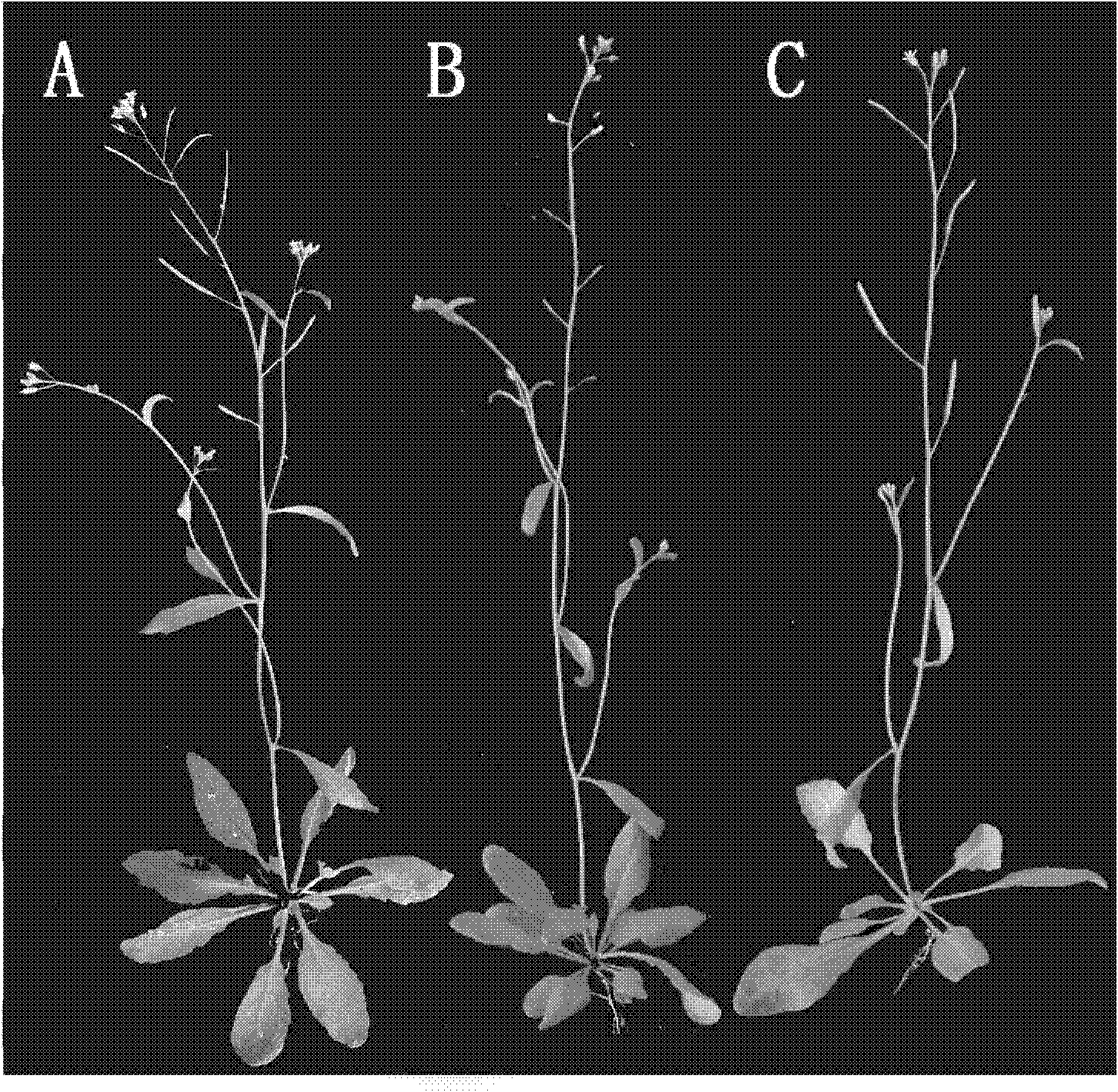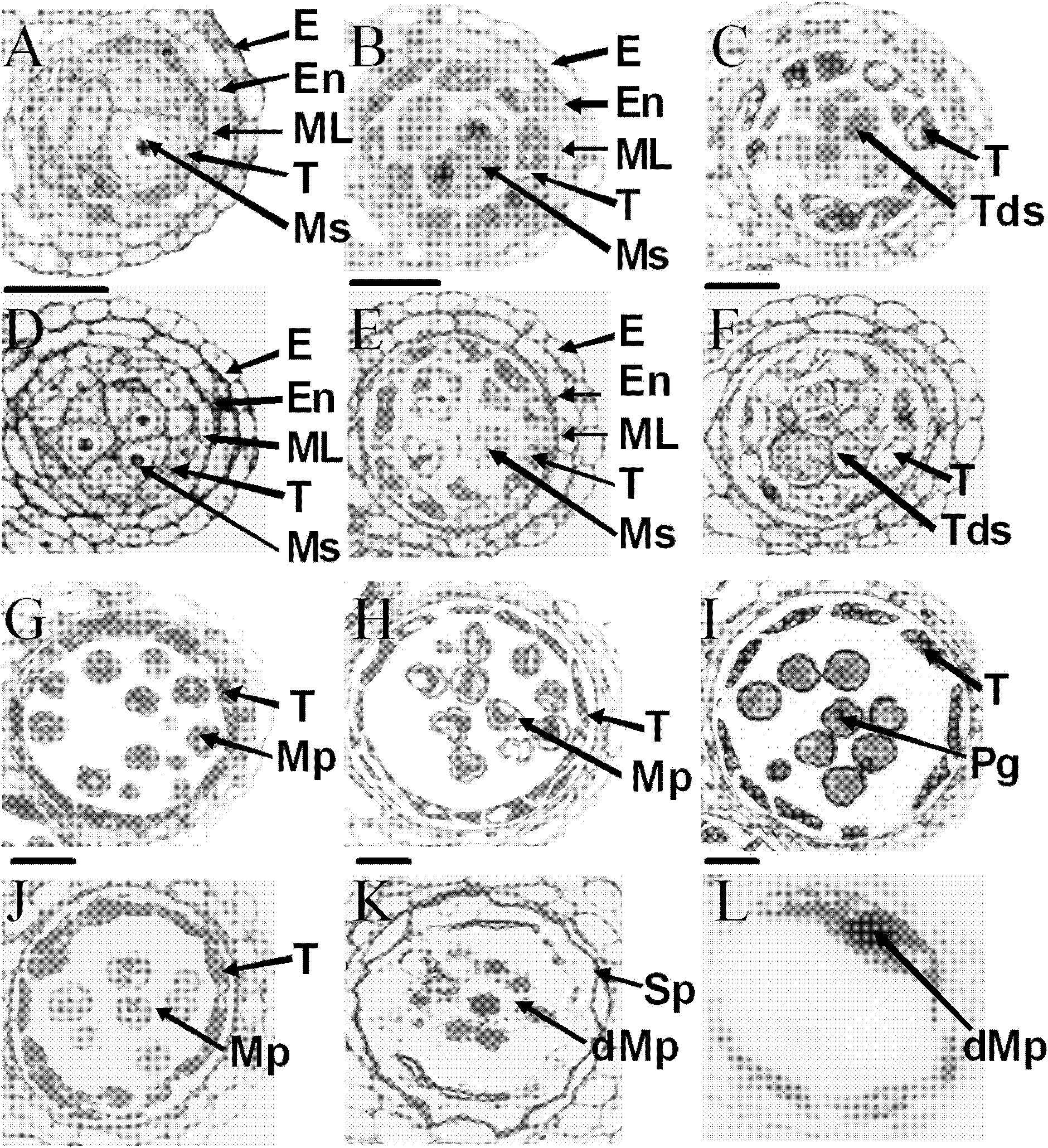Anther development control gene and application thereof to male sterility of arabidopsis
A technology for anthers and uses, applied in the field of plant biology, can solve problems such as unclear molecular mechanisms
- Summary
- Abstract
- Description
- Claims
- Application Information
AI Technical Summary
Problems solved by technology
Method used
Image
Examples
Embodiment 1
[0064] 1. Arabidopsis thaliana mutant arf17, the original wild type is Columbia (Col) ecotype (preserved by the Laboratory of Plant Molecular Biology, Shanghai Normal University).
[0065] 2. Arabidopsis material cultivation conditions: Arabidopsis was cultured in black soil; vermiculite; perlite (1:6:0.25) mixed soil after vernalization in 0.1% agarose at 4° C. for 2-4 days. Cover the upper layer with a plastic film to maintain humidity during cultivation, and remove the plastic layer when Arabidopsis germinates cotyledons. The light time is 16 hours of light, 8 hours of darkness, the humidity is kept at 60-70%, the temperature is controlled at 22-25°C, and the light intensity is 50μEm -2 the s -1 , the nutrient solution is PNS (Table 1).
[0066] Table 1. PNS stock composition and 1 L 1×PNS recipe
[0067]
[0068] a: Na 2 - 7.45g of EDTA and 5.57g of FeSO were dissolved in 400mL of water and heated to boiling, then mixed, and continued to boil for 30min, cooled and a...
Embodiment 2
[0079] Example 2 Cytological observation
[0080] 1. Light microscope resin sections of plant anthers: get arf17 mutants and wild-type fresh materials and put them into penicillin vials equipped with FAA fixative (50% alcohol, 5.0% glacial acetic acid, and 3.7% formaldehyde), pump air and remove them. Seal and store overnight at 4°C. It was subsequently dehydrated through gradient alcohols (50%×2, 60%, 70%, 80%, 90%, 95%, and 100%×2), transferred into xylene, and finally embedded in resin. Slices were then stained with toluidine blue and observed under a microscope. For callose staining, the sections were stained with 0.067M phosphate buffer solution containing 0.05% (w / v) aniline blue, and placed under a UV microscope for observation.
[0081] 2. Production of plant anther materials for electron microscopy: material production for scanning electron microscopy: fresh anthers and pollen of arf17 mutants and wild types were fixed on a copper platform with conductive glue, and ...
Embodiment 3
[0083] Example 3 Plant tissue extraction of RNA and RT-PCR detection of downstream genes:
[0084] The fresh material of arf17 mutant and wild type was ground thoroughly with liquid nitrogen in a mortar. Put the ground material into the EP tube that has been added with 1mL TRIZOL in advance, shake and mix well. Add chloroform after incubating at 15-30°C, after standing still, centrifuge at 12000g, then transfer the water phase to another EP tube, add isopropanol, centrifuge at 12000g at 4°C after standing still, then wash once with 75% alcohol, Dry the RNA and dissolve it in 20-40 μL DEPC-H 2in o. Then an appropriate amount of RNA was reverse-transcribed with AMV reverse transcriptase to synthesize the first strand of cDNA. The cDNA synthesized above was used as an amplification template for RT-PCR. The semi-quantitative RT-PCR program is pre-denaturation at 95°C for 5 minutes; denaturation at 95°C for 30 sec, annealing at 56°C for 30 sec, and extension at 72°C for 30 sec....
PUM
 Login to View More
Login to View More Abstract
Description
Claims
Application Information
 Login to View More
Login to View More - R&D
- Intellectual Property
- Life Sciences
- Materials
- Tech Scout
- Unparalleled Data Quality
- Higher Quality Content
- 60% Fewer Hallucinations
Browse by: Latest US Patents, China's latest patents, Technical Efficacy Thesaurus, Application Domain, Technology Topic, Popular Technical Reports.
© 2025 PatSnap. All rights reserved.Legal|Privacy policy|Modern Slavery Act Transparency Statement|Sitemap|About US| Contact US: help@patsnap.com



